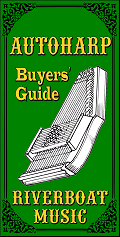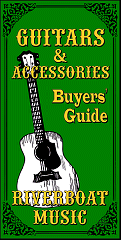THE TRUE HISTORY OF THE AUTOHARP
by Ivan Stiles
First published in Autoharp Quarterly(R), Volume 3, Number 3. April, 1991.
 Editor's Note: Paul Race here. As Folksinger since the 1960s and a former history book editor and fact-checker, I found my musical and historical curiosity piqued when I acquired a pre-war Model 73 about 2013. Editor's Note: Paul Race here. As Folksinger since the 1960s and a former history book editor and fact-checker, I found my musical and historical curiosity piqued when I acquired a pre-war Model 73 about 2013.
At the time, my early research on the internet (and even a couple of books) turned up a lot of "urban legends," assertions that had been made so often that many autoharp players took them as fact.
This included things like false claims about history, about specific instruments, about historical autoharp players, and more.
That's one reason I started tracking down obscure instruments and writing articles about what I actually learned: to get the facts out there. And, to be fair, most of what I see other folks posting these days is far more accurate than what I used to see.
The invention of the autoharp, though, was the "biggie." For some people it still is.
I was, frankly, incredulous when people showed me C.F. Zimmermann's patent application (the one that looks like a crossbow), and told me it was proof that he had invented the autoharp we know and love, an entirely different instrument.
Finally, I stumbled across an article by Ivan Stiles, a longtime autoharp player and teacher, as well as a dedicated researcher. It connected the dots for me in ways that the version everybody "knew" versions did not. I've also managed to independently verify several of Ivan's assertions through external sources.
When I incorporated Ivan's findings into my own "History of the Autoharp" article, several "experts" responded in anger. Why? Because what I was publishing wasn't what they been told and had been telling other people for years. I still haven't found any evidence that Ivan is wrong, however, and there's a lot of evidence that he is right.
At this point, it hardly matters, for reasons I explain in the conclusion, but I think people deserve to know the facts about things that are important to them.
At any rate, here is the article Ivan Stiles originally published in Autoharp Quarterly(R) all the way back in 1991:
P.S. Pardon me for omitting the umlaut over the "u" in the name Gutter. It doesn't show up correctly on everyone's system.
For years, we have read that Charles F. Zimmermann of Philadelphia, Pennsylvania invented what we call the autoharp. America would certainly have something to be proud of - if, in fact, it were true.
Sometime in 1989, I had a conversation with Mark Fackeldey (1988 International Autoharp Champion) during which he asked me, "What's this I read about the autoharp not being invented by Zimmermann?" This more than piqued my curiosity. Mark went on to say that the 1988 edition of the Encyclopaedia Britannica listed the inventor of the autoharp as C. A. Gutter.
Was it Zimmermann, or was it Gutter? To understand fully what transpired in the early days of the autoharp, we first have to look at exactly what Zimmermann patented. The first thing we see is that Zimmermann's instrument bears little resemblance to what we call an autoharp. This fact seems to
have been either ignored or glossed over by autoharp historians. Aside from the obvious difference in the shape of the instrument, the mechanism used to damp the strings is significantly different from the autoharp as we know it. Instead of depressing the chord bar vertically to damp the strings, the bar on the Zimmermann instrument is pulled horizontally by a "trigger." The felts extend down from the bar and went in between the strings. The strings are damped by pulling sideways. It is interesting to note that
this method would have made the multiple-chord bar impossible. (On a multi-chord bar, certain felts were moved laterally to a different position by a lever which allowed one bar to function for more
than one chord.)

Another difference is the incorporation of a flageolet bar. This bar is in the center of the chord bar arrangement and over the exact center of each string. When this bar was utilized with another chord bar, the result was a raise in pitch of the chosen chord to one octave higher.
The following are the first two paragraphs of Zimmermann's patent. "To all whom it may concern: Be it known that I, Charles F. Zimmermann, a citizen of the United States, resident of the city and county of Philadelphia, in the State of Pennsylvania, have invented certain new and useful Improvements in Harps, of which the following is a specification, reference being had to the accompanying drawings, wherein - Figure 1 is a plan of a harp with my improvements shown as applied thereto. Fig. 2 is an elevation on line 1-1, Fig. 1; Fig. 3 is an enlarged vertical section on line 2-2, Fig. 1. Fig. 4 is a similar view on line 3-3, Fig. 1; and Fig. 5 is a broken plan, partly in section, of the appliances constituting my invention, and shown as drawn to an enlarged scale."
It is clear, upon reading the patent, that Zimmermann has never claimed to have invented a new instrument, but rather - " . . . certain new and useful Improvements in Harps . . . " These improvements
are clearly referred to as " . . . the appliances constituting my invention . . . " Zimmermann also refers
to " . . . a harp with my improvements shown as applied thereto." Again, this is a reference to his improvements, not a new instrument.

Zimmermann makes one more reference to his invention when he states in another paragraph of his patent, "Such appliances I call 'trigger-bars,' and they are arranged transversely with the strings of the harp. A harp so provided has the size of a zither, and which I term an 'autoharp,' and the manner in which the instrument is played is entirely new." At this point, Zimmermann has very clearly established the concept that any harp outfitted with his invention would constitute an autoharp. To date, no such instrument has ever been uncovered. It can be assumed that at least one instrument was built since we have a photograph of Zimmermann playing it. However, it probably was built after the patent was received since he did not submit a model of his invention when application was made for the patent.
Now, we'll look at Gutter's instrument. The drawing shown is from a British patent which had been "Communicated from abroad by J. M. Grob, of Leipzig, and K. A. Gutter, of Markneukirchen, both in the German Empire." There is no reason to describe this instrument since it is obviously the instrument we call an autoharp today. One can see that it is identical in shape and function to the instrument that Zimmermann produced and called the "Autoharp."

According to A. Doyle Moore, the autoharp was not manufactured in Philadelphia until 1885
("The Autoharp: Its Origin and Development from a Popular to a Folk Instrument," New York
Folklore Quarterly, Vol. 19, No. 4, December, 1963). This occurred approximately one year after Gutter's British patent was published.
What this all really boils down to is that Zimmermann never produced what he patented and he never patented what he produced. Instead, he manufactured Gutter's instrument and called it an "autoharp." He also put his patent number on the instrument - a patent issued for "new and useful Improvements." Had he, in fact, employed his chord bar improvements, then we could give credit to Zimmermann for
a new way of playing a harp. However, what we are playing today is actually Gutter's chord zither,
or "Volkszither," and not Zimmermann's "Autoharp."
Tracking down the true inventor of what we call the autoharp was not an easy process. After my first conversation with Mark Fackeldey, I checked out many books which all gave credit to Zimmermann.
I then discovered a reference to Gutter in "Grove's Encyclopedia of Musical Instruments." It listed only his name and where he lived (Markneukirchen, Germany). Further research led me to the Philadelphia Free Library and the Curtis Institute in Philadelphia, the Stearns Collection of the University of Michigan at Ann Arbor, the East German Embassy in Washington, D.C., the Lincoln Center Library
and the Goethe House Library in New York City, numerous museums and libraries in Germany including the Musikinstrumenten-Museum der Musikstadt Markneukirchen, the German Patent Office, and the C. Robert Hopf Company, the only remaining factory still producing autoharps in Germany. One very educational day was spent in the foreign patent section of the United States Patent Office. It was there that the Gutter drawing surfaced. The research was greatly expedited by the efforts of supervisor, Bernard Hamilton. Helpful personnel like Mr. Hamilton make every penny of tax money that goes to the Patent Office worthwhile. The Musikinstrumenten-Museum der Markneukirchen also supplied a wealth of information through its museum assistant, Th Kunze.
What did we discover about Gutter? Christian August Gutter was born on July 22, 1823 and died
on September 21, 1900. And, despite what the reference books say, his name was actually Karl, not Christian. He lived his life in Markneukirchen, Germany and had nine children. (Three of those children emigrated to the United States.) Some sources list Gutter as a violin maker and others say that he was
a guitar maker. Regardless, it is safe to say that he was the man who gave us the instrument we
enjoy today.
In 1883, Gutter sold the rights to the chorded zither to Herman Lindemann from Klingenthal, near Markneukirchen. Lindemann's company traded in all types of musical instruments. Lindemann must have been quite irritated that others were manufacturing an instrument for which he owned the patent.
In a monthly journal of 1890, he published the following statement: "Warning: I warn hereby especially not to buy or sell the recently sold instrument under the name of Chordzither or Autoharp that are in
the market as imitations of my patent 'Volkszither.' I sued through the district attorney against the manufacturer C. F. Thierfeld against patent rights. Everyone of those individuals should be brought
to court who sells these imitations in the stores." - Signed: H. Lindemann, The Only Manufacturer
of the Patented and Privileged "Volkszither."
One question still persists. Why didn't Zimmermann produce the improvements he invented? The answer to this may never be known. Zimmermann had a long history of failed business ventures and perhaps his new design gave him problems when he went to manufacture it. Zimmermann's patent
notes that no model was supplied with the drawings. Perhaps he felt that Gutter's design was easier to manufacture than his. It's difficult to reconstruct a history that is shrouded in mystery, but one thing can be postulated: Zimmermann probably learned about the chorded zither during a return trip to Germany where he saw the instrument that was perfect for employing his tone-numbering system which he had patented in 1871.
Many questions regarding the history of Gutter's instrument will also have to go unanswered. According to Messrs. Hopf of the C. Robert Hopf Company in Germany, "Perhaps our father and certainly our grandfather could have given you some information about the 'Volkszither' patent rights and the like, but unfortunately, neither a family chronicle nor other material still exists. We suppose that such documents got lost during or shortly after World War II. And under the socialist system in the former GDR, nobody took an interest in the history of a private firm - just the opposite. Our firm, C. Robert Hopf, was nationalized in 1972 and became part of the combined works 'VEB Musikinstrumentenbau Markneukirchen' like Messrs. Rauner which was liquidated as a zither producing firm later on."
Even though we know that Zimmermann did not invent the chord zither, he certainly was responsible
for popularizing the instrument in the United States. However, now that the true history of the autoharp is known, it is important to give credit to Karl August Gutter, the real inventor of the instrument we know as the autoharp.
As appeared in Autoharp Quarterly(R), Volume 3, Number 3. April, 1991.
Conclusion
Paul again: I'm realizing now that some owners' insistence that Zimmerman and his successors made the only "true" autoharps was just a form of brand loyalty, the same kind of loyalty folks show to pickup trucks and sports teams. Sadly, in the years since I was virtually called a heretic for restoring a German autoharp, much of that brand loyalty has been mitigated by the declining quality of the current products being manufactured under the Oscar Schmidt brand name.
So if you bring a non-OS autoharp into a room or online discussion with seasoned autoharp players, you're much more likely to be encouraged than you would have been a decade or two ago.
On the other hand, there's a new class of autoharp owners who claim that the only autoharps worth owning are the expensive luthier-built ones, and anything else ought to fuel your next bonfire.
Sorry, but I get as much fun out of playing my wanky old relics as I do my fancy new custom instruments - they provide different, but equally fun experiences.
In other words, what kind of autoharp(s) you own and play is a personal choice. Period.
Thanks, Ivan, for permission to repost this article for our readers.
 Whatever else you get out of our pages, I hope you come away with some great ideas for "sharing the joy." Whatever else you get out of our pages, I hope you come away with some great ideas for "sharing the joy."
And please stay in touch!
- Paul Race







| 







 Editor's Note: Paul Race here. As Folksinger since the 1960s and a former history book editor and fact-checker, I found my musical and historical curiosity piqued when I acquired a pre-war Model 73 about 2013.
Editor's Note: Paul Race here. As Folksinger since the 1960s and a former history book editor and fact-checker, I found my musical and historical curiosity piqued when I acquired a pre-war Model 73 about 2013.








































